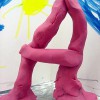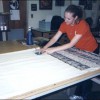- Keith Haring Murals in San Sebastián
- Keith Haring Murals
- Come To Know Keith Haring
- Organ Systems Mural
- City as Canvas: Artist Spotlight
- Printing with Objects
- Mural Making in the Style Of Keith Haring
- Subway Graffiti Project
- T-shirt Designer
- Keith Haring Semiotics Poster
- Introducing Keith Haring
- Discovering Keith Haring
- Haring Inspired Mural
- All Bottled Up!
- Thinking about Drawings as Symbols
Curriculum | Language Arts
Hip Hop Dance Cut-Outs
Emphasizing collaboration, this teacher brought in music that Keith Haring worked to when he was making art and helped her students create a mural using it as inspiration.
Big Hat People
Influenced by Keith Haring's book, BIG, this lesson explores clothing and the adjectives we use to describe and differentiate them.
Marbling a la Haring
Using the process of paper marbling, this teacher has found a way to help students deconstruct and compose their own abstract compositions.
Creating Stories
Looking and drawing merge in this lesson to help students understand and appreciate Keith Haring's work. As an extension to this project, these NYC school children decorated bags containing holiday gifts for local charities.
Symbols to Sculptures
Designed by the Museum Educators at the Art Gallery of Ontario in Toronto, Canada, this lesson encourages students to consider shapes as a construct for symbol making. The project proposes a transformation from 2-dimensional drawings to synthesized, 3-dimensional forms.
Symbols & Signs
An activity provided by the Art Gallery of Ontario, this lesson seeks to help children identify and express their emotions through lines and symbols, just as Keith Haring did.
Line & Expression – 2D
An activity provided by the Art Gallery of Ontario designed to teach children about Keith Haring's art, specifically his art-making methods and his use of line and shape to create a symbolic language.
Line & Expression – 3D
An activity provided by the Art Gallery of Ontario designed to help students understand meanings and representations of symbols and to synthesize 2-dimensional imagery into 3-dimensional forms

